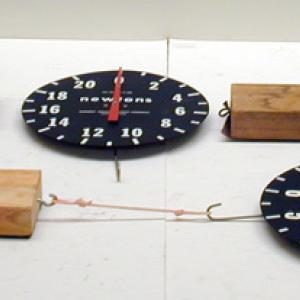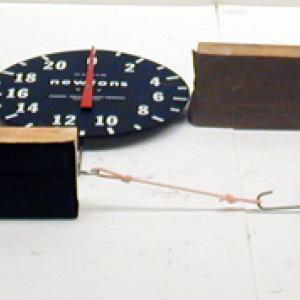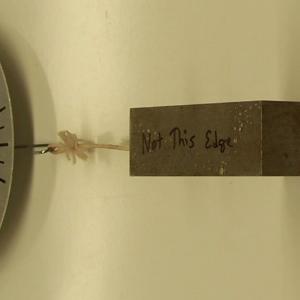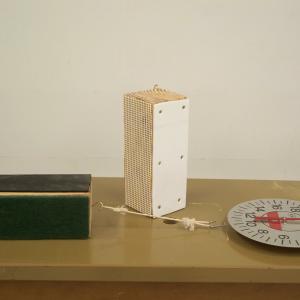College of Liberal Arts & Sciences
1K20.10 - Friction Blocks
1 and 2 kg slotted weights may be put on the friction blocks that have the pegs sticking out of the middle.
The metal block is used on the masonite surface to show that the friction does not depend on surface area for the same object. Use the flat wide side or the narrow side of the block to show the same frictional value.
- David Rakestraw, Denvir Higgins, Donte Harris, Mitchell Allen, Eddie Red, Dawson Lang, Maria Gamez, David A. Strubbe, "Exploring Newton's Second Law and Kinetic Friction Using the Accelerometer Sensor in Smartphones", TPT, Vol. 61, #6, Sept. 2023, p. 473.
- Paul Hewitt, "Figuring Physics", TPT, Vol. 61, #3, March 2023, p. 227.
- Chokchai Puttharugsa, Surawut Wicharn, Suwan Plaipichit, Supitch Khemmani, "Determining the Coefficient of kinetic Friction Using Smartphone Sensors", TPT, Vol. 59, #6, Sept. 2021, p. 504.
- Paul Hewitt, "Figuring Physics November 2019 Solution", TPT, Vol. 57, #9, Dec. 2019, p. 651.
- Milentije Lukovic, "The Influences of Surface Temperature on the Coefficient of Static Friction", TPT, Vol. 57, #9, Dec. 2019, p. 636.
- Susan M. Renner and Daniel D. Schwert, "Exploring Friction with the Ancient Egyptians", TPT, Vol. 57, #9, Dec. 2019, p. 624.
- Kenneth D. Hahn and Jacob M. Russell, "Correction: 'The Indeterminate Case of Classical Static Friction when Coupled with Tension,' by Kenneth D. Hahn and Jacob M. Russell (Feb. 2018), p. 83", TPT, Vol. 56, #3, Mar. 2018, p. 131.
- Kenneth D. Hahn and Jacob M. Russell, "The Indeterminate Case of Classical Static Friction When Coupled with Tension", TPT, Vol. 56, #2, Feb. 2018, p. 83.
- Peter Kalajian and Maria Makarova, "Friction and the Intuition-Outcome Disparity", TPT, Vol. 52, #3, Mar. 2014, p. 172.
- Peter Kalajian and Maria Makarova, "Friction and the Intuition-Outcome Disparity", TPT, Vol. 52, #2, Feb. 2014, p. 84.
- Paul Dolan, "But Is It Good For Anything", TPT, Vol. 49, #6, Sept. 2011, p. 324.
- Paul Dolan, "What Physics Principle Can I Teach with This?", TPT, Vol. 49, #4, Apr. 2011, p. 249.
- Richard Humbert, "Propelling Extended Objects", TPT, Vol. 48, #3, Mar. 2010, p. 169.
- Dan Ludwigsen and Kathryn Svinarich, "Author's Response", TPT, Vol. 47, #6, Sept. 2009, p. 326.
- Gabriel Kessler, "Comments on Static vs Kinetic Friction", TPT, Vol. 47, #6, Sept. 2009, p. 326.
- Daniel Ludwigsen and Kathryn Svinarich, "Choose Wisely: Static or Kinetic Friction—The Power of Dimensionless Plots", TPT, Vol. 47, #3, Mar. 2009, p. 158.
- T. M. Lawlor, "Being Careful with PASCO's Kinetic Friction Experiment: Uncovering Pre-Sliding Displacement?", TPT, Vol. 46, #7, Oct. 2008, p. 432.
- Paul Hewitt, "Figuring Physics: Action-Reaction", TPT, Vol. 46, #6, Sept. 2008, p. 326.
- Carl E. Mungan, "Author's Response", TPT, Vol. 45, #7, Oct. 2007, p. 405.
- Kai Neergård, "Energy and Work", TPT, Vol. 45, #7, Oct. 2007, p. 404.
- Mojca Čepič, "Work and Energy", TPT, Vol. 45, #7, Oct. 2007, p. 404.
- Carl E. Mungan, "Thermodynamics of a Block Sliding Across a Frictional Surface", TPT, Vol. 45, #5, May 2007, p. 288.
- Se-yuen Mak and Siu-ling Wong, "A Brush-Creeper", TPT, Vol. 44, #9, Dec. 2006, p. 572.
- Paul Hewitt, "Figuring Physics: Skidding to a Stop", TPT, Vol. 44, #9, Dec. 2006, p. 571.
- Dick C. H. Poon, "Work, Energy Transfer, and Sliding Friction", TPT, Vol. 44, #4, Apr. 2006, p. 232.
- Peter Sullivan, Joseph Novak, and Philip Sancilio, "A Block Dragging a Cart", TPT, Vol. 44, #2, Feb. 2006, p. 114.
- Mark Kinsler and Evelyn Kinzel, "A Simple Lab Exercise to Determine the Coefficient of Static Friction", TPT, Vol. 44, #2, Feb. 2006, p. 77.
- T. P. Doerr, "Note on 'Smart' Forces", TPT, Vol. 39, #8, Nov. 2001, p. 486.
- William J. Leonard, "Dragging a Box: The Representation of Constraints and the Constraint of Representations", TPT, Vol. 39, #7, Oct. 2001, p. 412.
- Ronald Newburgh, "Other 'Smart' Forces", TPT, Vol. 39, #3, Mar. 2001, p. 133.
- Jonathan F. Reichert, "How Did Friction Get So 'Smart'?", TPT, Vol. 39, #1, Jan. 2001, p. 29.
- Willem H. van den Berg, "The Best Angle for Dragging a Box", TPT, Vol. 38, #8, Nov. 2000, p. 506.
- Rebecca Morrow, Alistair Grant, and David P. Jackson, "A Strange Behavior of Friction", TPT, Vol. 37, #7, Oct. 1999, p. 412.
- Se-yuen Mak, "Easy to Do", TPT, Vol. 36, #6, Sept. 1998, p. 327.
- Slawomir Piatek and Ronald Gautreau, "Constant Acceleration and Kinetic Friction", TPT, Vol. 36, #5, May 1998, p. 316.
- Ed van den Berg and Cor van Huis, "Drawing Forces", TPT, Vol. 36, #4, Apr. 1998, p. 222.
- Paul Hewitt, "Figuring Physics", TPT, Vol. 35, #7, Oct. 1997, p. 412.
- Stanley P. Morris, "Effect of the Moment of Inertia of a Pulley", TPT, Vol. 29, #5, May 1991, p. 265.
- Charles J. Reidl Jr., "The Coefficient of Kinetic Energy", TPT, Vol. 28, #6, Sept. 1990, p. 402.
- Hilliard K. Macomber, "Normal and Frictional Forces: An Experiment", TPT, Vol. 17, #9, Dec. 1979, p. 593.
- Claudio González, "Friction Does Not Always Oppose the Net Force", TPT, Vol. 15, #8, Nov. 1977, p. 452.
- Mumtaz A. Dinno and Thomas L. Holloman, "Friction in the Solution of Basic Dynamic Problems", TPT, Vol. 14, #4, Apr. 1976, p. 233.
- Harold J. Born, "Coefficient of Friction Apparatus", TPT, Vol. 12, #6, Sept. 1974, p. 367.
- Patton H. McGinley, "Cookie Sheet Friction", TPT, Vol. 11, #6, Sept. 1973, p. 362, also A Potpourri of Physics Teaching Ideas - Mechanics, p. 8.
- S. L. Gerhard, "More Chalk Talk", TPT, Vol. 3, #6, Sept. 1965, p. 283.
- Grant O. Gale, "Chalk Talk", TPT, Vol. 3, #1, Jan. 1965, p. 23.
- Ugo Besson, Lidia Borghi, Anna De Ambrosis, and Paolo Mascheretti, "How to Teach Friction: Experiments and Models", AJP, Vol. 75, #12, De. 2007, p. 1106.
- Rod Cross, "Increase in Friction Force with Sliding Speed", AJP, Vol. 73, #9, Sept. 2005, p. 812.
- Timothy J. Folkerts, "Exploring Factors Affecting Measurements of the Static Coefficient of Friction: An Application of Fractional Factorial Experiment Design", AJP, Vol. 72, #10, Oct. 2004, p. 1335.
- James Ringlein and Mark O. Robbins, "Understanding and Illustrating the Atomic Origins of Friction", AJP, Vol. 72, #7, July 2004, p. 884.
- J. Krim, "Resource Letter: FMMLS-1: Friction at Macroscopic and Microscopic Length Scales", AJP, Vol. 70, #9, Sept. 2002, p. 890.
- J. A. Fox, "Study of Sliding Friction as a Sophomore Physics Experiments", AJP, Vol. 33, #7, July 1965, p. 587.
- Richard J. Fitzgerald, "A New Look at Friction", Physics Today, Vol. 48, #1, Jan. 2010, p. 16.
- Jacqueline Krim and Robert P. Behringer, "Friction, Force Chains, and Falling Fruit", Physics Today, Vol. 47, #9, Sept. 2009, p. 66.
- "M-340. Coin on Table & 4-Sided Block", DICK and RAE Physics Demo Notebook.
- G. D. Freier and F. J. Anderson, "Mk-1", A Demonstration Handbook for Physics.
- Robert Ehrlich, "D.4, Launching a Sliding Block With Known Velocity", Turning the World Inside Out and 174 Other Simple Physics Demonstrations, p. 42 - 43.
- Robert Ehrlich, "D.3. Pulling a Sliding Brick", Turning the World Inside Out and 174 Other Simple Physics Demonstrations, p. 41 - 42.
- David Kutliroff, "28, Drag a Trunk with a Scale", 101 Classroom Demonstrations and Experiments For Physics Teachers, p. 64.
- Borislaw Bilash II and David Maiullo, "Riding Your Groove", A Demo a Day: A Year of Physics Demonstrations, p. 71.
- Borislaw Bilash II and David Maiullo, "What Are You Composed Of? Revisited", A Demo a Day: A Year of Physics Demonstrations, p. 24.
- Curt Suplee, "Friction: Durable Foe", Everyday Science Explained, National Geographic, p. 30 - 31.
- Curt Suplee, "Friction as Friend", Everyday Science Explained, National Geographic, p. 28 - 29.
- W. Bolton, "1. Friction and Footwear", Book 1 - Properties of Materials, Physics Experiments and Projects, 1968, p. 61 - 62.
- Borislaw Bilash II, “Fighting Friction“, A Demo A Day – A Year of Physical Science Demonstrations, p. 222.
- Julius Sumner Miller, Q146 & A146, Millergrams II – Some More Enchanting Questions for Enquiring Minds, p. 28 & 87.
- Julius Sumner Miller, Q155 & A155, Millergrams II – Some More Enchanting Questions for Enquiring Minds, p. 34 & 91.
- Julius Sumner Miller, Q218 & A218, Millergrams II – Some More Enchanting Questions for Enquiring Minds, p. 67 & 115.
Disclaimer: These demonstrations are provided only for illustrative use by persons affiliated with The University of Iowa and only under the direction of a trained instructor or physicist. The University of Iowa is not responsible for demonstrations performed by those using their own equipment or who choose to use this reference material for their own purpose. The demonstrations included here are within the public domain and can be found in materials contained in libraries, bookstores, and through electronic sources. Performing all or any portion of any of these demonstrations, with or without revisions not depicted here entails inherent risks. These risks include, without limitation, bodily injury (and possibly death), including risks to health that may be temporary or permanent and that may exacerbate a pre-existing medical condition; and property loss or damage. Anyone performing any part of these demonstrations, even with revisions, knowingly and voluntarily assumes all risks associated with them.



